Aochuan Chen
A Survey of Cross-domain Graph Learning: Progress and Future Directions
Mar 14, 2025
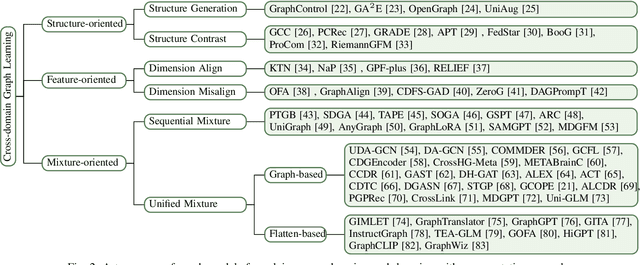


Abstract:Graph learning plays a vital role in mining and analyzing complex relationships involved in graph data, which is widely used in many real-world applications like transaction networks and communication networks. Foundation models in CV and NLP have shown powerful cross-domain capabilities that are also significant in graph domains. However, existing graph learning approaches struggle with cross-domain tasks. Inspired by successes in CV and NLP, cross-domain graph learning has once again become a focal point of attention to realizing true graph foundation models. In this survey, we present a comprehensive review and analysis of existing works on cross-domain graph learning. Concretely, we first propose a new taxonomy, categorizing existing approaches based on the learned cross-domain information: structure, feature, and structure-feature mixture. Next, we systematically survey representative methods in these categories. Finally, we discuss the remaining limitations of existing studies and highlight promising avenues for future research. Relevant papers are summarized and will be consistently updated at: https://github.com/cshhzhao/Awesome-Cross-Domain-Graph-Learning.
Parameter-Efficient Fine-Tuning via Circular Convolution
Jul 27, 2024Abstract:Low-Rank Adaptation (LoRA) has gained popularity for fine-tuning large foundation models, leveraging low-rank matrices $\mathbf{A}$ and $\mathbf{B}$ to represent weight changes (\textit{i.e.,} $\Delta \mathbf{W} = \mathbf{B} \mathbf{A}$). This method reduces trainable parameters and mitigates heavy memory consumption associated with full delta matrices by sequentially multiplying $\mathbf{A}$ and $\mathbf{B}$ with the activation. Despite its success, the intrinsic low-rank characteristic may limit its performance. Although several variants have been proposed to address this issue, they often overlook the crucial computational and memory efficiency brought by LoRA. In this paper, we propose \underline{C}ir\underline{c}ular \underline{C}onvolution \underline{A}daptation (C$^3$A), which not only achieves high-rank adaptation with enhanced performance but also excels in both computational power and memory utilization. Extensive experiments demonstrate that C$^3$A consistently outperforms LoRA and its variants across various fine-tuning tasks.
GLBench: A Comprehensive Benchmark for Graph with Large Language Models
Jul 11, 2024



Abstract:The emergence of large language models (LLMs) has revolutionized the way we interact with graphs, leading to a new paradigm called GraphLLM. Despite the rapid development of GraphLLM methods in recent years, the progress and understanding of this field remain unclear due to the lack of a benchmark with consistent experimental protocols. To bridge this gap, we introduce GLBench, the first comprehensive benchmark for evaluating GraphLLM methods in both supervised and zero-shot scenarios. GLBench provides a fair and thorough evaluation of different categories of GraphLLM methods, along with traditional baselines such as graph neural networks. Through extensive experiments on a collection of real-world datasets with consistent data processing and splitting strategies, we have uncovered several key findings. Firstly, GraphLLM methods outperform traditional baselines in supervised settings, with LLM-as-enhancers showing the most robust performance. However, using LLMs as predictors is less effective and often leads to uncontrollable output issues. We also notice that no clear scaling laws exist for current GraphLLM methods. In addition, both structures and semantics are crucial for effective zero-shot transfer, and our proposed simple baseline can even outperform several models tailored for zero-shot scenarios. The data and code of the benchmark can be found at https://github.com/NineAbyss/GLBench.
Parameter-Efficient Fine-Tuning with Discrete Fourier Transform
May 05, 2024Abstract:Low-rank adaptation~(LoRA) has recently gained much interest in fine-tuning foundation models. It effectively reduces the number of trainable parameters by incorporating low-rank matrices $A$ and $B$ to represent the weight change, i.e., $\Delta W=BA$. Despite LoRA's progress, it faces storage challenges when handling extensive customization adaptations or larger base models. In this work, we aim to further compress trainable parameters by enjoying the powerful expressiveness of the Fourier transform. Specifically, we introduce FourierFT, which treats $\Delta W$ as a matrix in the spatial domain and learns only a small fraction of its spectral coefficients. With the trained spectral coefficients, we implement the inverse discrete Fourier transform to recover $\Delta W$. Empirically, our FourierFT method shows comparable or better performance with fewer parameters than LoRA on various tasks, including natural language understanding, natural language generation, instruction tuning, and image classification. For example, when performing instruction tuning on the LLaMA2-7B model, FourierFT surpasses LoRA with only 0.064M trainable parameters, compared to LoRA's 33.5M. Our code is released at \url{https://github.com/Chaos96/fourierft}.
All in One and One for All: A Simple yet Effective Method towards Cross-domain Graph Pretraining
Feb 15, 2024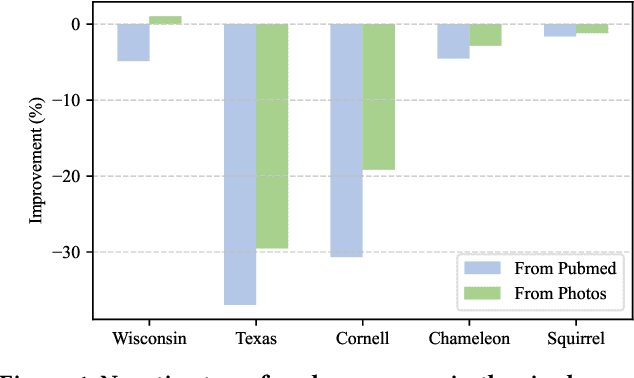



Abstract:Large Language Models (LLMs) have revolutionized the fields of computer vision (CV) and natural language processing (NLP). One of the most notable advancements of LLMs is that a single model is trained on vast and diverse datasets spanning multiple domains -- a paradigm we term `All in One'. This methodology empowers LLMs with super generalization capabilities, facilitating an encompassing comprehension of varied data distributions. Leveraging these capabilities, a single LLM demonstrates remarkable versatility across a variety of domains -- a paradigm we term `One for All'. However, applying this idea to the graph field remains a formidable challenge, with cross-domain pretraining often resulting in negative transfer. This issue is particularly important in few-shot learning scenarios, where the paucity of training data necessitates the incorporation of external knowledge sources. In response to this challenge, we propose a novel approach called Graph COordinators for PrEtraining (GCOPE), that harnesses the underlying commonalities across diverse graph datasets to enhance few-shot learning. Our novel methodology involves a unification framework that amalgamates disparate graph datasets during the pretraining phase to distill and transfer meaningful knowledge to target tasks. Extensive experiments across multiple graph datasets demonstrate the superior efficacy of our approach. By successfully leveraging the synergistic potential of multiple graph datasets for pretraining, our work stands as a pioneering contribution to the realm of graph foundational model.
To Generate or Not? Safety-Driven Unlearned Diffusion Models Are Still Easy To Generate Unsafe Images For Now
Oct 18, 2023Abstract:The recent advances in diffusion models (DMs) have revolutionized the generation of complex and diverse images. However, these models also introduce potential safety hazards, such as the production of harmful content and infringement of data copyrights. Although there have been efforts to create safety-driven unlearning methods to counteract these challenges, doubts remain about their capabilities. To bridge this uncertainty, we propose an evaluation framework built upon adversarial attacks (also referred to as adversarial prompts), in order to discern the trustworthiness of these safety-driven unlearned DMs. Specifically, our research explores the (worst-case) robustness of unlearned DMs in eradicating unwanted concepts, styles, and objects, assessed by the generation of adversarial prompts. We develop a novel adversarial learning approach called UnlearnDiff that leverages the inherent classification capabilities of DMs to streamline the generation of adversarial prompts, making it as simple for DMs as it is for image classification attacks. This technique streamlines the creation of adversarial prompts, making the process as intuitive for generative modeling as it is for image classification assaults. Through comprehensive benchmarking, we assess the unlearning robustness of five prevalent unlearned DMs across multiple tasks. Our results underscore the effectiveness and efficiency of UnlearnDiff when compared to state-of-the-art adversarial prompting methods. Codes are available at https://github.com/OPTML-Group/Diffusion-MU-Attack. WARNING: This paper contains model outputs that may be offensive in nature.
Selectivity Drives Productivity: Efficient Dataset Pruning for Enhanced Transfer Learning
Oct 16, 2023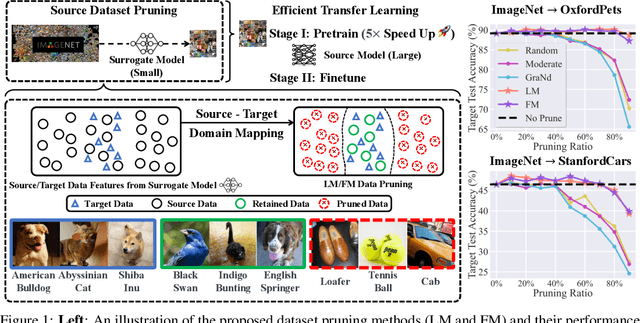


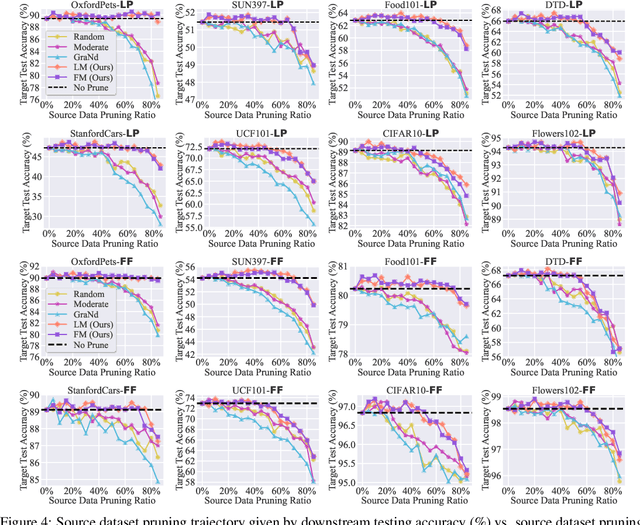
Abstract:Massive data is often considered essential for deep learning applications, but it also incurs significant computational and infrastructural costs. Therefore, dataset pruning (DP) has emerged as an effective way to improve data efficiency by identifying and removing redundant training samples without sacrificing performance. In this work, we aim to address the problem of DP for transfer learning, i.e., how to prune a source dataset for improved pretraining efficiency and lossless finetuning accuracy on downstream target tasks. To our best knowledge, the problem of DP for transfer learning remains open, as previous studies have primarily addressed DP and transfer learning as separate problems. By contrast, we establish a unified viewpoint to integrate DP with transfer learning and find that existing DP methods are not suitable for the transfer learning paradigm. We then propose two new DP methods, label mapping and feature mapping, for supervised and self-supervised pretraining settings respectively, by revisiting the DP problem through the lens of source-target domain mapping. Furthermore, we demonstrate the effectiveness of our approach on numerous transfer learning tasks. We show that source data classes can be pruned by up to 40% ~ 80% without sacrificing downstream performance, resulting in a significant 2 ~ 5 times speed-up during the pretraining stage. Besides, our proposal exhibits broad applicability and can improve other computationally intensive transfer learning techniques, such as adversarial pretraining. Codes are available at https://github.com/OPTML-Group/DP4TL.
DeepZero: Scaling up Zeroth-Order Optimization for Deep Model Training
Oct 03, 2023Abstract:Zeroth-order (ZO) optimization has become a popular technique for solving machine learning (ML) problems when first-order (FO) information is difficult or impossible to obtain. However, the scalability of ZO optimization remains an open problem: Its use has primarily been limited to relatively small-scale ML problems, such as sample-wise adversarial attack generation. To our best knowledge, no prior work has demonstrated the effectiveness of ZO optimization in training deep neural networks (DNNs) without a significant decrease in performance. To overcome this roadblock, we develop DeepZero, a principled ZO deep learning (DL) framework that can scale ZO optimization to DNN training from scratch through three primary innovations. First, we demonstrate the advantages of coordinate-wise gradient estimation (CGE) over randomized vector-wise gradient estimation in training accuracy and computational efficiency. Second, we propose a sparsity-induced ZO training protocol that extends the model pruning methodology using only finite differences to explore and exploit the sparse DL prior in CGE. Third, we develop the methods of feature reuse and forward parallelization to advance the practical implementations of ZO training. Our extensive experiments show that DeepZero achieves state-of-the-art (SOTA) accuracy on ResNet-20 trained on CIFAR-10, approaching FO training performance for the first time. Furthermore, we show the practical utility of DeepZero in applications of certified adversarial defense and DL-based partial differential equation error correction, achieving 10-20% improvement over SOTA. We believe our results will inspire future research on scalable ZO optimization and contribute to advancing DL with black box.
Understanding and Improving Visual Prompting: A Label-Mapping Perspective
Nov 21, 2022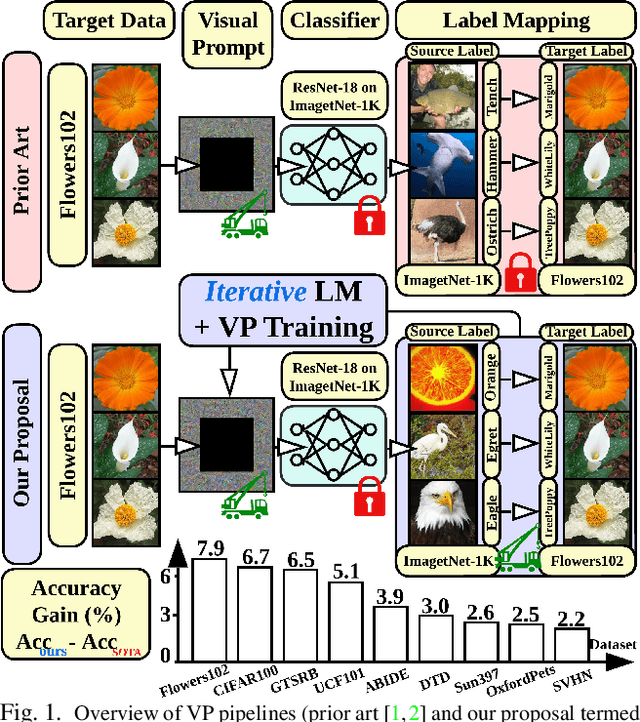
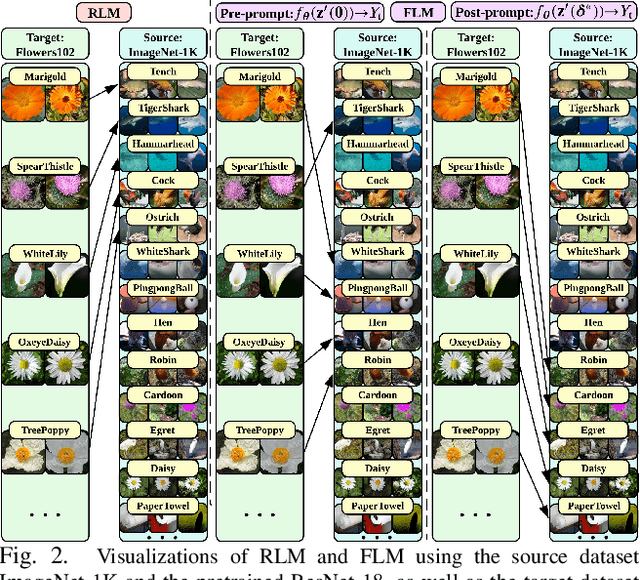
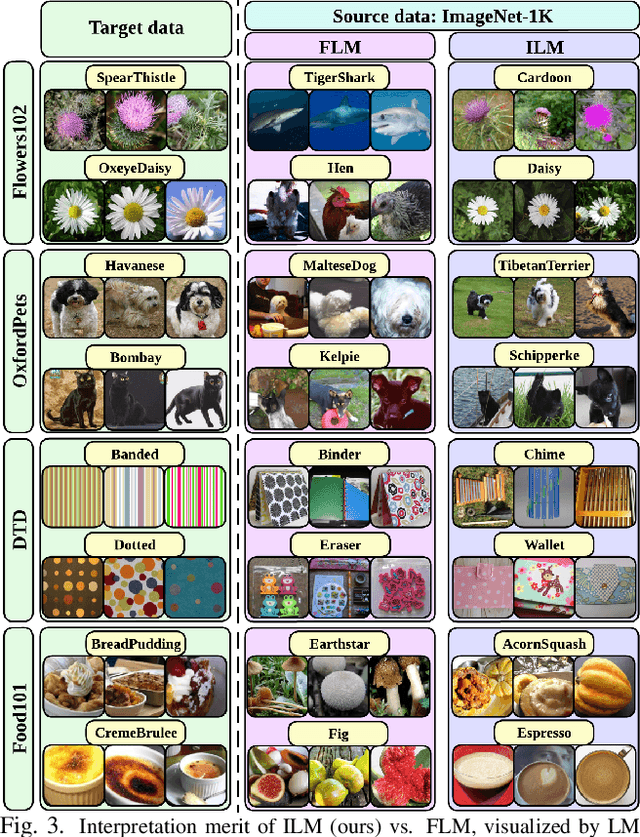
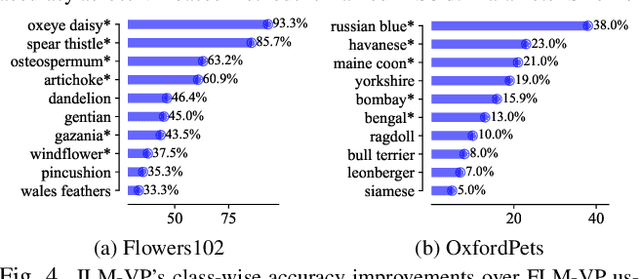
Abstract:We revisit and advance visual prompting (VP), an input prompting technique for vision tasks. VP can reprogram a fixed, pre-trained source model to accomplish downstream tasks in the target domain by simply incorporating universal prompts (in terms of input perturbation patterns) into downstream data points. Yet, it remains elusive why VP stays effective even given a ruleless label mapping (LM) between the source classes and the target classes. Inspired by the above, we ask: How is LM interrelated with VP? And how to exploit such a relationship to improve its accuracy on target tasks? We peer into the influence of LM on VP and provide an affirmative answer that a better 'quality' of LM (assessed by mapping precision and explanation) can consistently improve the effectiveness of VP. This is in contrast to the prior art where the factor of LM was missing. To optimize LM, we propose a new VP framework, termed ILM-VP (iterative label mapping-based visual prompting), which automatically re-maps the source labels to the target labels and progressively improves the target task accuracy of VP. Further, when using a contrastive language-image pretrained (CLIP) model, we propose to integrate an LM process to assist the text prompt selection of CLIP and to improve the target task accuracy. Extensive experiments demonstrate that our proposal significantly outperforms state-of-the-art VP methods. As highlighted below, we show that when reprogramming an ImageNet-pretrained ResNet-18 to 13 target tasks, our method outperforms baselines by a substantial margin, e.g., 7.9% and 6.7% accuracy improvements in transfer learning to the target Flowers102 and CIFAR100 datasets. Besides, our proposal on CLIP-based VP provides 13.7% and 7.1% accuracy improvements on Flowers102 and DTD respectively. Our code is available at https://github.com/OPTML-Group/ILM-VP.
Visual Prompting for Adversarial Robustness
Oct 12, 2022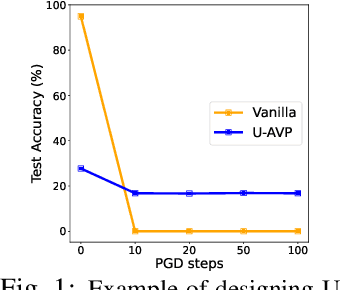
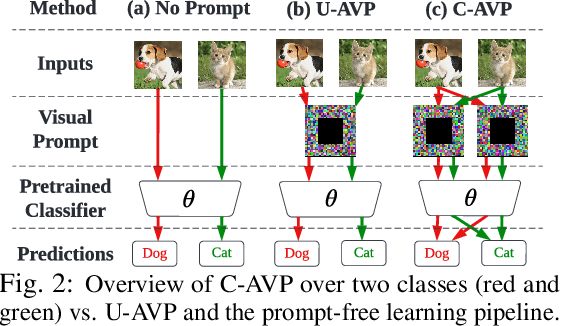
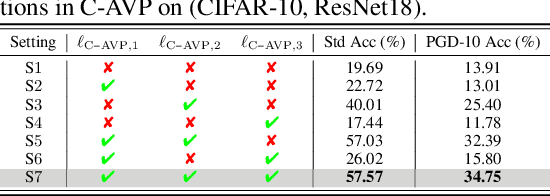

Abstract:In this work, we leverage visual prompting (VP) to improve adversarial robustness of a fixed, pre-trained model at testing time. Compared to conventional adversarial defenses, VP allows us to design universal (i.e., data-agnostic) input prompting templates, which have plug-and-play capabilities at testing time to achieve desired model performance without introducing much computation overhead. Although VP has been successfully applied to improving model generalization, it remains elusive whether and how it can be used to defend against adversarial attacks. We investigate this problem and show that the vanilla VP approach is not effective in adversarial defense since a universal input prompt lacks the capacity for robust learning against sample-specific adversarial perturbations. To circumvent it, we propose a new VP method, termed Class-wise Adversarial Visual Prompting (C-AVP), to generate class-wise visual prompts so as to not only leverage the strengths of ensemble prompts but also optimize their interrelations to improve model robustness. Our experiments show that C-AVP outperforms the conventional VP method, with 2.1X standard accuracy gain and 2X robust accuracy gain. Compared to classical test-time defenses, C-AVP also yields a 42X inference time speedup.
 Add to Chrome
Add to Chrome Add to Firefox
Add to Firefox Add to Edge
Add to Edge